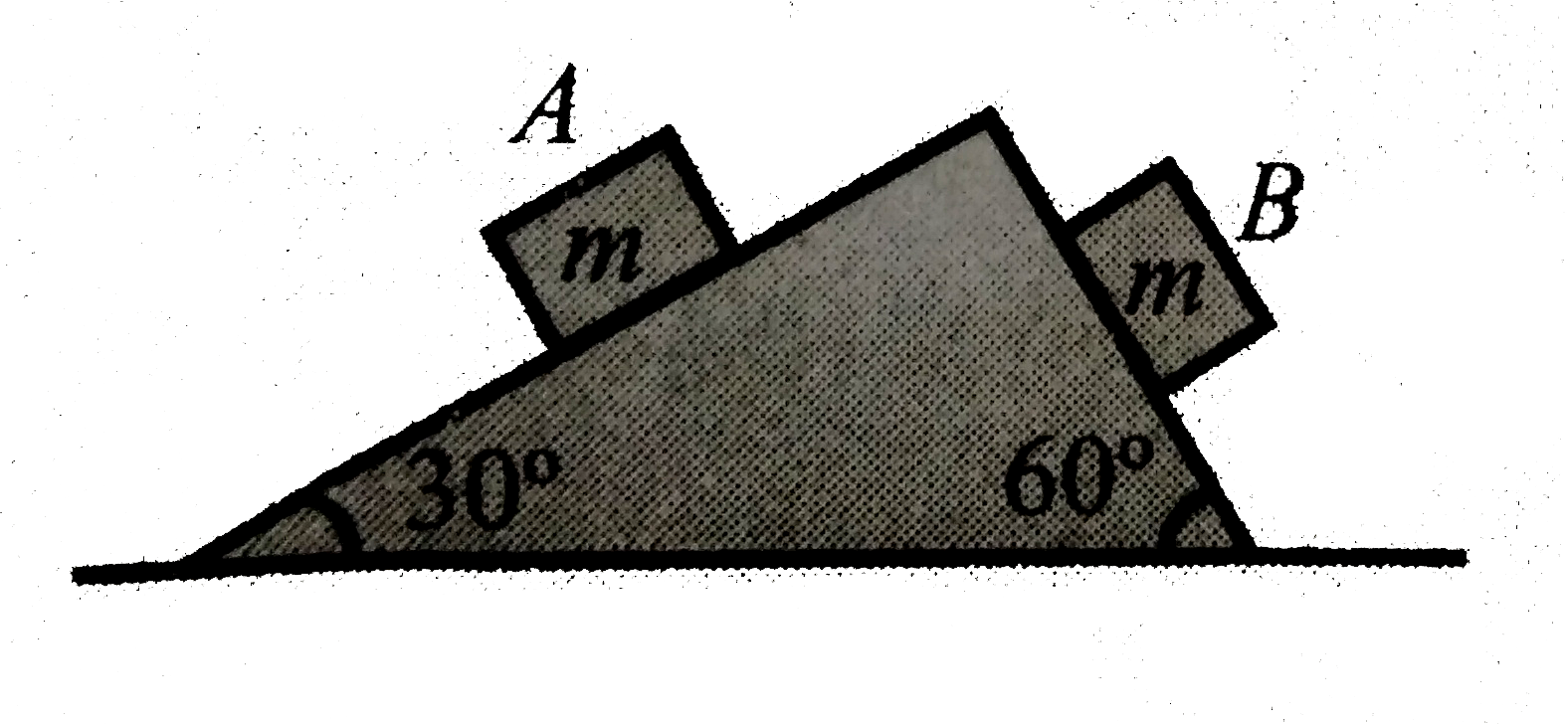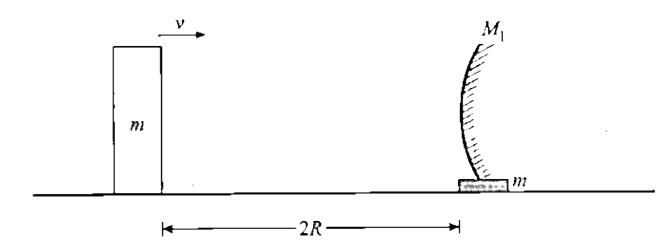Two concave mirrorsof equal radi of curvature R are fixed on a stand facing opposite directions. The whole system has a mass m nd is kept onn a frictionlesss horiztonal table figure

Two blocks A and B, each of mass m, are placed on the two side of the stnd. At t=0, teh separation between A and the mirrors is 2R and also the separation between B and the mirrors is 2R. The block B moves towards the mirror at a speed v. All collisions which take place are erastic. Taking the original position of the mirrors stand system to be x=0 and X -axis along AB, find the position of the image of A and B at t=
a.Rυ, b. 3Rυ c. 5Rυ
At t=RV,XA=−2r3andXB=R
At t=3RV,XA=−2RandXB=0
At t=5RV,XA=−3RandXB=−4R3
At t=5RV,XA=−4R3andXB=−3R
The correct Answer is:A, B, C
At t=RV
use mirror formula −2R=1VB−1R
⇒VB=−R
Hence XAB=R
similarly XVA=−2R3
(ii) At t=3R3
As after 2RV time velocities are exchanged
VA=−R
∴XVA=−2R
and VB=−T
∴XVB=0
(iii) at t=5RV
As after 2RV time velocities are exchanged
Hence VA=−R but position XVA=−3R
and VB=−2R3
∴XVB=−4R3
Topper's Solved these Questions
- DAILY PRACTICE PROBLEMBOOK - RESONANCE ENGLISHCHAPTER - DAILY PRACTICE PROBLEMEXERCISE - DPP No.58
20 Videos
- DAILY PRACTICE PROBLEMBOOK - RESONANCE ENGLISHCHAPTER - DAILY PRACTICE PROBLEMEXERCISE - DPP No.59
9 Videos
- DAILY PRACTICE PROBLEMBOOK - RESONANCE ENGLISHCHAPTER - DAILY PRACTICE PROBLEMEXERCISE - DPP No.56
20 Videos
- CURRENT ELECTRICITYBOOK - RESONANCE ENGLISHCHAPTER - CURRENT ELECTRICITYEXERCISE - High Level Problems (HIP)
19 Videos
- ELECTRO MAGNETIC WAVESBOOK - RESONANCE ENGLISHCHAPTER - ELECTRO MAGNETIC WAVESEXERCISE - Exercise 3
27 Videos
Similar Questions
Four point masses each of mass m are placed on vertices of a regular tetrahedron. Distance between any two masses is r.
View SolutionTwo blocks A and B each of equal masses m are released from the top of a smooth fixed wedge as shown in the figure. Find the magnitude of the acceleration of the centre of mass of the two blocks.

View Solution
Knowledge Check
Four point masses each of mass m are placed on vertices of a regular tetrahedron. Distance between any two masses is r.
AGravitation field at centre at zeroBGravitation potential at centre is −4GmrCGravitation potential energy of system in −6Gm2rDGravitation force on one of the point mass is √6Gm2r2Two blocks each having a mass M are placed as shown in the figure. The accleration of the system is:-
 A0Bgsinθ2CgsinθD2gsinθ
A0Bgsinθ2CgsinθD2gsinθ
Two blocks A and B each of equal masses m are rleased from the top of a smooth fixed wedge as shown in the figure. Find the magnitude of the accelertion of the centre of mass of the two blocks.

View SolutionTwo blocks each of mass m are placed on a smooth horizontal surface.They attract each other with a force F=kr where r is the separation between them.Calculate work required to increase the separation between the blocks slowly from a to 2a.
View SolutionTwo blocks each having a mass M are placed as shown in the figure. The accleration of the system is:-

View SolutionA Convex mirror of radius of curvature R is fixed on a standat rest with total mass m which is facing a block of equal mass m as shown in figure and is kept on a frictionless horizontal surfece. The separation between the block and mirror is 2R and block is moving at a speed v toward the mirror. Consider elastic collision between block and stand, find the speed of image after time 3R/v.

View SolutionA small block of mass m and a concave mirror of radius R fitted with a stand lie on a smooth horizontal table with a separation d between them. The mirror together with its stand has a mass m. The block is pushed at t = 0 towards the mirror so that it starts moving towards the mirror at a constant speed V and collides with it. The collision is perfectly elastic. Find the velocity of the image (a) at a time t<dV, (b) at a time t>dV.
View SolutionA small block of mass m and a concave mirror of radius R fitted with a stand lie on a smooth horizontal table with a separation d between them. The mirror together with its stand has a mass m. The block is pushed at t = 0 towards the mirror so that it starts moving towards the mirror at a constant speed V and collides with it. The collision is perfectly elastic. Find the velocity of the image (a) at a time t<dV, (b) at a time t>dV.
View Solution
